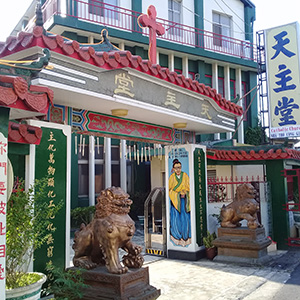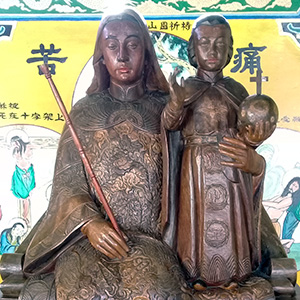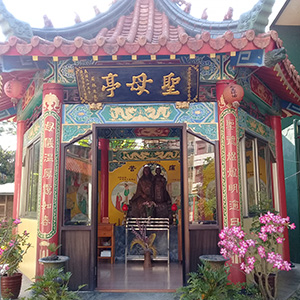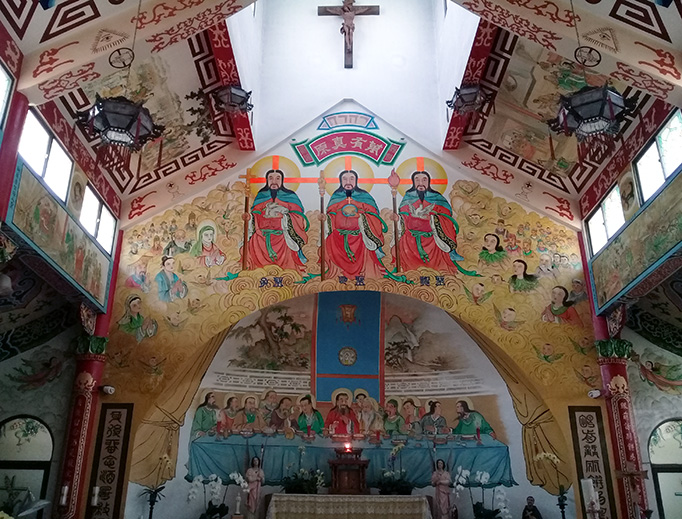Taiwan's Holy Trinity Church Draws Souls to Christ
Holy Trinity Church is a marvel that surprises Chinese and Western, Christian and non-Christian alike.

In my travels, I've seen the magnificent cathedrals of Europe. I've made pilgrimages to Santiago de Compostela, Rome and Jerusalem. I've even visited Yamoussoukro Basilica, also known as Our Lady of Peace Basilica in the Ivory Coast―the largest Christian church building in the world―which is said to be larger than St. Peter’s Basilica.
Notre Dame, Fatima, Lourdes, Knock, Guadalupe, Monte Cassino, Assisi, Reims, Rouen, Strasbourg, Cologne, Las Lajas, Zaragoza. Each one more impressive than the last.

And yet, I was stunned into reverential silence/shocked awe when I encountered Holy Trinity Church in Yanshui, Taiwan. Truth be known, I could barely suppress a gasp of joy at seeing the church's interior.
I came across the church a few years ago while ago when I volunteered as a lay missionary in Taiwan.
One could easily walk past it presuming it yet another of the ubiquitous Taoist temples found throughout Taiwan… that is, until one notes the crucifix and campanile and the enormous mural of Jesus.
Nothing could prepare me for the masterpiece of Holy Trinity Church in Yanshui, Taiwan. This is not a church one should miss. My Taiwanese friends wanted to surprise me so they sent me in without so much as a warning to “Take a deep breath!” and, when I stepped into this holy space, I nearly had the wind knocked out of me.
High above the street, on the outside of the church, the building sports a mural depicting Christ teaching His Disciples.
That was an eye-opener especially considering all those depicted had Asian features and wore Asian garb.
Two enormous and seriously impressive stone lion-dog guardian statues (獅, also known as foo dogs) guard the gate to the church's courtyard. The gate itself is a typical gate one finds at a Taoist or even in a Japanese Shinto temple.
Like its Taoist temple counterpart, the interior of Holy Trinity Church is a veritable riot of vibrant colors, sights and sounds.

Every aspect of the traditional Taoist temple is replicated, baptized and made Christian all for the greater glory of God. The church is designed to seriously impress with the hope that it would bring those who entered to the True Faith.
Vibrant red is an auspicious color in Chinese culture and the church is swathed in it. Considering the inordinately long list of Chinese martyrs with which the Church has been blessed, the use of that color is thoroughly in keeping with Christian tradition.
An enormous incense bowl burns before the otherwise traditional altar as is the custom in even more European-styled Catholic churches throughout Asia. Whereas we light candles to signal our personal intentions, the Chinese and other Asians will light thin incense sticks and place them upright in the sand-filled incense bowls."
A tiny chapel in the back of the church houses a fairly large, traditional looking reliquary with the earthly remains of at least 12 saints in it including St. Thérèse of Lisieux and St. Anthony of Padua.
An enormous gong announces the moment of transubstantiation at Mass rather than the traditional altar or sanctus bell rung by an altar boy. The gong is so large, it would have made Bombardier Billy Wells and J. Arthur Rank jealous. (Technically, the Rank Films' gong was only made of papier-mâché!)
It's sure to wake up the people in the back row.
I will admit that the most jarring of the murals inside the “Temple of Heaven” was a depiction of the Trinity that looked a little too much like how the Buddha is usually depicted. However, in the artist's defense, Christ and His Blessed Mother are often drawn looking like the people who drew them. For example, at the Shrine of Our Lady of Guadalupe, the Virgin seems like a Mexican girl. If you look closely, you'll note she's wearing a black sash which is reserved for women who are pregnant in that culture.
The interior and exterior murals display in one single instance, a great number of the events of Christ's life in very much the same way stained glass windows, painting and statues would instruct the Faithful in more traditional churches throughout Christendom.

Holy Trinity Catholic Church is one of most featured Catholic churches in Taiwan. The main hall is dubbed the “Temple of Heaven” and was built in 1986 under the direction of Father Eusebius. In an attempt to reach out to the local people, the Franciscan priest filled the interior of the church with Chinese-style decoration and murals.
His efforts have seen the baptism of countless Chinese ever since he commissioned the church.
Over the years, this has been born out, as Sr. Christina (one of the Poor Clares who are responsible for the church) told the Register.
“This is certainly true,” she said. “We have a large number of pilgrims and tourists who come here to marvel at our little church. It's truly beautiful. A great merger and mixture of two spiritual traditions that would bring Taoists and Buddhists to Christ.”
Above the altar is the Chinese version of Michelangelo's Last Supper mural, which substitutes ancient, traditional Hebrew clothing and physical characteristics for Chinese ones. In fact, one can easily spot a common Chinese food on the table before Christ and His Apostles known as baozi (i.e., steamed stuffed buns - 包子). The walls opposite the altar are painted with murals depicting God creating the universe as described in Genesis. They certainly challenge a Western Christian's understanding of classic religious art.
For those who insist that Catholic churches shouldn't emulate pagan art, this is shortsighted. In fact, the general basilica-style architecture was taken from the shape of civil buildings used throughout the Roman Empire at the time of Constantine. In fact, the title Pontifex Maximus (Latin, literally: "greatest bridge-builder") was the name given to the high priest of the College of Pontiffs (Collegium Pontificum) in ancient Rome.
Our Christmas trees were taken from a Germanic pagan custom of bringing evergreen boughs into the home at wintertime to assure the preservation of life and fertility.
Does anyone object to the foo dogs in front of this church? Perhaps one should be more concerned with the demonic gargoyles adorning the spires of more traditional Gothic churches.
And though Easter is clearly the celebration of the Pesach, or the Passing Over of the Lord, and His Resurrection, the English translation may refer to Ēostre, a pagan Germanic goddess of spring.
This is the genius of Christianity―we take what is available, sanctify it and transform it to offer it as gift to the Creator of All.
Holy Trinity Church is a marvel that surprises Chinese and Western, Christian and non-Christian alike. It overpowers, delights and surprises you. Very much like the Lord of All.
Holy Trinity Church is located at 155 Hoping Street, Chiali Chen, Yanshui, (Tainan Hsien) Taiwan, R.O.C. Sunday and weekend Masses are at 8:00 a.m. Masses are celebrated in Mandarin (though many of the Poor Clares speak English).
For more information, see http://www.catholic.org.tw/tainan/c29/c.htm and https://www.pinterest.com/pin/454230312395898458/.














